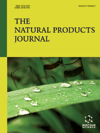- Home
- A-Z Publications
- Natural Products Journal, The
- Previous Issues
- Volume 7, Issue 3, 2017
Natural Products Journal, The - Volume 7, Issue 3, 2017
Volume 7, Issue 3, 2017
-
-
Phytochemistry and Pharmacology of Callistemon viminalis (Myrtaceae): A Review
More LessAuthors: Kamal Ahmad and Fareeda AtharCallistemon viminalis (weeping bottlebrush), belongs to the family Myrtaceae, is known to have medical importance. An ornamental plant stands for its numerous attributes such as antioxidant, moluscicidal, antibacterial, antifungal, allelopathic, anti-platelet aggregation, anti-quorum sensing, anti-infective, anti-helminthic and has also been found as an effective insecticidal activity. This plant possesses a wide range of secondary m Read More
-
-
-
Phytochemical Composition, Biological Activities and Processing Method of Genus Anisophyllea: A Review
More LessAnisophyllea disticha is one of the species of genus Anisophyllea that is not pharmacologically investigated despite its high utilization by the folklore. Leaf, stem and root of this plant are being used especially in treating diarrhea, dysentery, jaundice, refreshing men128;™s body, revitalizing the birth canal of women after delivering the baby as well as relieving weariness and body aches. The medicinal properties of A. disticha are Read More
-
-
-
Identification of GTP Binding Nuclear Protein Ran as an Upregulation Target in Acetoin Glucoside Mediated Plant Growth Enhancement
More LessBackground: In recent decade, researchers aim to exploit the growth regulators from natural sources due to adverse effects posed by chemical fertilizers. Ash gourd waste (peel and seeds) has been traditionally used as a green manure for increasing the soil nutrients. The role of acetoin, a major aroma compound of ash gourd (Benincasa hispida), and its glucosidic precursor as a plant growth promoter was investigated in th Read More
-
-
-
Characterization of the Lipid Fraction of Cocoplum Seeds (Chrysobalanusicaco, L) for Use in the Food Industry
More LessBackground: The cocoplum (Chrysobalanus icaco, L) is in the Chrysobalanaceae family. It has a pantropical distribution, with 18-20 genuses and at least 500 species. This family is comprised of trees and shrubs, with alternating, simple leaves with stipules (small and deciduous). Objective: The objectives of this study were to determine: (1) the fatty acid profile in cocoplum (Chrysobalanus icaco, L) seed oil by High Resolution Gas Read More
-
-
-
Biosynthesis and Biological Activities of In Vitro Derived Solasodine Glycoalkaloids from Solanum laciniatum
More LessBackground: Glycoalkaloids production from natural plants suffers from many problems, including instability and scarcity. The scope of the study was to biosynthesize these important metabolites via plant tissue culture as alternative way besides, evaluating their biological activities. Method: Solasodine glycoalkaloids production potentiated in cultures of Solanum laciniatum leaves on Murashige and Skoog (MS) media containin Read More
-
-
-
Chemical Characterization and Antioxidant Potential of Athroisma proteiformis Essential Oil
More LessObjective: n the present study, the essential oil of Athroisma proteiformis was characterized for the first time. Method: GC-HRMS (Gas Chromatography-High Resolution Mass Spectrometry) was performed for qualitative and quantitative analysis of the phytochemicals present in the extract. Chemical analyses were conducted to evaluate the total phenols, total flavonoids and antioxidant activity of the extract. Results: Read More
-
-
-
Nigragillin, Nigerazine B and Five Naphtho-γ-pyrones from Aspergillus japonicus Isolated from Hot Desert Soil
More LessBackground: Microorganisms are highly diverse sources of bioactive natural products. A valuable set of fungi has been encountered in the hot Egyptian desert soils. The aims of this paper were to isolate soil thermophilic fungi and detect their bioactive metabolites. Methods: Direct incorporation method of soil into PDA medium is used for fungal isolation. The metabolic extracts of the isolated fungi were assayed aga Read More
-
-
-
Single Crystal X-Ray Diffraction in Structure Elucidation of Arborinine from Glycosmis pentaphylla
More LessAuthors: Moon M. Das, Dibakar Chandra Deka and Ranjit ThakuriaBackground: Arborinine is a naturally found alkaloid with various biological activities. It has been isolated from the leaf extract of Glycosmis pentaphylla, a traditionally used medicinal plant of North East of India. Single crystal X-ray diffraction on arborinine has never been reported earlier. Objective: The main objective of the present study is to report the isolation and characterization of arborinine and its single crystal X-ray Read More
-
-
-
Vitexin with its Derivatives is Responsible for the Cholinomimetic Properties of Penianthus longifolius Extract which Stimulates Muscarinic Receptors
More LessAuthors: Kenneth G. Ngwoke, Chinazo Ezenkwu, Daniel Lotanna Ajaghaku and Peter ProkschBackground: Alzheimer's disease is a neurodegenerative disease that affects about 47.5 million people worldwide, a number that is expected to double every 20 years. Available treatments are only palliative because none of the cholinomimetic agents is curative or preventive and they mostly come with severe side effects. The discovery of safer and more effective medications is an unmet healthcare need. Penianthus l Read More
-
-
-
In Vitro Tyrosinase Inhibitory and Antioxidant Activities of Extracts and Constituents of Paeonia lactiflora Pall. Flowers
More LessBackground: In recent years researchers have undertaken the search for antioxidant compounds that can delay or inhibit the initiation or propagation of oxidative chain reaction and thus prevent or repair oxidative damage done to the body's cells by reactive oxygen species. Currently, a variety of synthetic antioxidant supplements are available. However, antioxidants derived from natural sources have attracted many i Read More
-
Most Read This Month
Article
content/journals/npj
Journal
10
5
false
en


